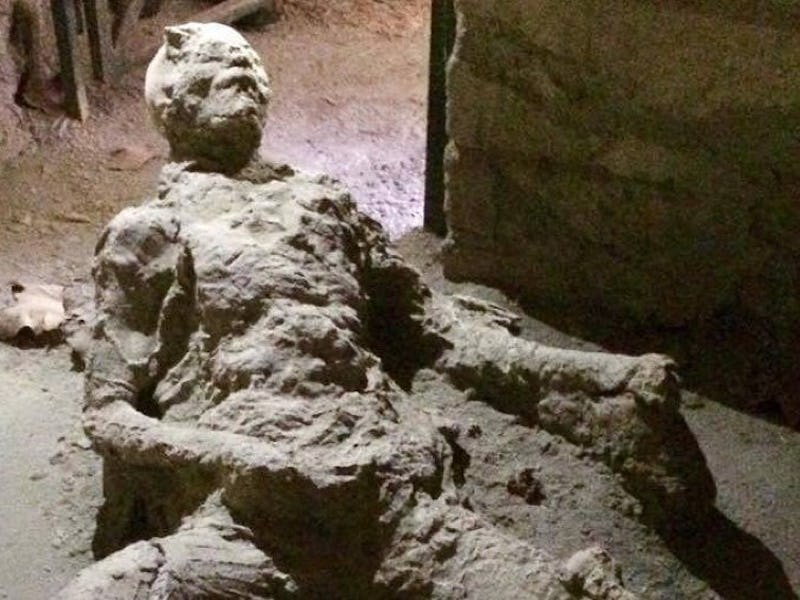How the Pompeii "Masturbator" Really Died When Vesuvius Erupted
The viral victim's compromising pose, explained.

A viral photo of an ancient volcano victim immortalized with his hands in a compromising position has called attention to a rarely considered but still-important question: Can people masturbate during a volcanic eruption?
Earth’s explosive volcanoes are notorious for unleashing 1,500-degree avalanches of scorching gas and rocks that flood down the flanks of a volcano, demolishing everything in their path. During these violent events, called pyroclastic flows, people don’t masturbate because they can’t. Instead, they promptly asphyxiate, cook to death, and die, as did the Pompeiian man who some think may have been indulging himself during the historic Mount Vesuvius eruption in 79 A.D.
“There is no way to demonstrate any ‘masturbating man,’ and it is out of place to discuss such an affirmation (I hope a joke, however bad) of some young time waster,” University of Naples Federico II volcanologist Pier Paolo Petrone, Ph.D., who has studied Mt. Vesuvius for decades, said in an interview with The Daily Dot on Monday. “The individual in the photo is an adult man, killed by the hot pyroclastic surge (hot gas and ash cloud which killed most of the population living around Mount Vesuvius), with both arms and legs flexed due to the heat.”
Some volcanoes, like Hawaii’s gentle lava-gushers, don’t erupt violently. But those that do, like Italy’s infamous Mount Vesuvius, contain a thick, viscous magma that holds in hundreds to thousands of years’ worth of bubbling heat and pressure. Before the grand event, the volcano trembles, sending earthquakes through the region some five to seven days in advance. Then comes the surreal pressure release, wherein a colossal column of ash, gas, and rock is blasted high into the atmosphere. The heavier elements of this ash cloud collapse into a pyroclastic flow, which in 79 A.D. buried a number of cities in the usually tranquil Bay of Naples, most famously Pompeii.
These days, nearly 2,000 years later, archaeologists commonly find hollow spaces in the layers of volcanic ash and rock that buried Pompeii. When plaster is poured into these spaces and the ash around it is chiseled away, human and animal forms in their last throes of life are revealed. Their cooked bodies decayed, leaving hollow molds of people cowering in hallways, praying, gripping each other, and, in the case of dogs, trying to break free from their chains.
But no one is masturbating.
A Pompeii man crawling before he was buried by Vesuvius's volcanic ash.
While it’s abundantly clear that a pyroclastic avalanche entombed the denizens of Pompeii, the precise cause of their prompt death is debatable, although the options are few. Vesuvius’s heated gases could have swept through the city’s doors and windows, causing people to suffocate before another flow of super-heated rock and ash engulfed their bodies. Another theory, published in the journal PLOS ONE in 2010, proposes that the blazing hot ash and gas swiftly killed them with flashes of temperatures exceeding 500 degrees Fahrenheit — which was enough to melt the Pompeian’s silverware. Such an event would have sizzled their skin and cooked their organs, which is why most of the figures are found in withering, contorted postures.
In either case — asphyxiation or being heated in a temporary volcanic oven — there is little chance that any man would have the ability to masturbate while being destroyed by Vesuvius’s fiery wrath.
A Roman dog withers in its last throes of life.